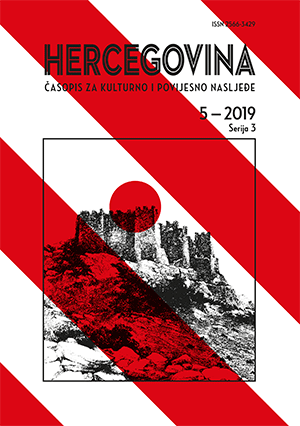Mostar u svjetlu znanstvenoga interesa starokršćanske arheologije
Mostar in the light of scientific interest of the early Christian archaeology
Author(s): Ivanka Ribarević-NikolićSubject(s): Christian Theology and Religion, Archaeology, Ancient World
Published by: Filozofski fakultet Sveučilišta u Mostaru - Studij povijesti i Hrvatski institut za povijest - Zagreb
Keywords: early Christian archaeology; Mostar; spolia; Donje Gnojnice; archaeological manifesto;
Summary/Abstract: Attention is given to the relief decorated late antique stone fragments which were built as spolia in the facade of a very interesting architectural construction with Islamic stylistic features of the spring "Vrelo Vrba" located in Donje Gnojnice, south of Mostar. Since we often find them as a decoration of the early Christian architectural sculpture, motifs of branches and vine leaves with bunches, hypothetically, point out the existence of the early Christian object in this place. At the same time, it is known that the motif of vine with bunches of grapes is not exclusively connected to sacral architecture in terms of iconography, therefore possibility of different provenance of this relief may not be excluded (Figure 1-3). Conservation works are necessary to be done for both late antique reliefs and the object "Vrelo Vrba". This space has not been archaeologically explored. The site was registered at the end of the 19th century.The article also points out the level of exploration and preservation of the seven so far known early Christian sites in the area of the present Municipality of Mostar. Those are Cim, Sutina, Potoci, Humilisani, Kuti, in the north part of the city and Zitomislici and Blagaj in the south part. There are three important early Christian sites where remains of architecture were confirmed by archaeological research method. Those are Cim, Zitomislici and Sutina (Figure 4, 5, 6). The archaeological site in Sutina was completely destroyed together with remains of the early Christian church architecture (Figure 6). The author gives a critical overview of the protection level of two conserved early Christian architectural sacral complexes, the one in Cim and the other in Zitomislici. Early Christian archaeological site in Cim (Figure 4) was endangered by aggressive housing construction. Early Christian architectural complex in Zitomislici (Figure 5) has not been adequately presented and it seems that nobody takes care of the site conservation. The article especially emphasizes necessity of the systematic archaeological research at some sites where the existence of the early Christian sacral architecture was confirmed, such as Humilisani site (Figure 7, 8).At the end of the article the author pointed out the value and significance of all the archaeological sites in general. Selected thoughts of scientists and artists were cited and consolidated as a symbolic message which we called archaeological manifesto: Archaeological sites are steps into the future and not return to the past.
Journal: Hercegovina. Časopis za kulturno i povijesno naslijeđe (od 2018)
- Issue Year: 2019
- Issue No: 5
- Page Range: 7-39
- Page Count: 33
- Language: Croatian

